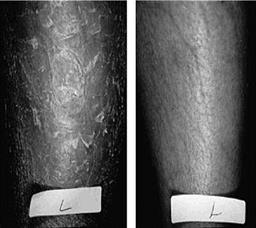The alpha-hydroxy acid (AHAs), polyhydroxy acids (PHAs) and bionic acids are exvuviating compounds that enhance desquamation and cell turnover. Because of the differences in their molecular structures, these compounds provide some additional benefits to skin as described below.
Alpha-Hydroxy Acids—Anti-aging Plus Exfoliation
AHAs, such as glycolic acid, lactic acid, and mandelic acid (Fig. 1), have many beneficial effects on skin including enhanced exfoliation as well as reversal of photoaging (24-27). Upon topical application, AHAs have been shown to have a profound effect on desquamation and exuviation, the natural process of epidermal cell turnover (Fig. 2). When applied to severely hyperkeratotic skin, such as ichthyosis, AHAs at cosmetic strengths [defined by the Cosmetic Ingredient Review panel as a concentration of 10% or less with a minimum pH of 3.5 (28)] cause separation of abnormally thick stratum corneum at the base of the stratum corneum, the layer known as the stratum compactum (6,29). In severely hyperkeratotic skin, the thickened stratum corneum lifts off as a sheet (6). This observation distinguishes the effects of AHAs from traditional, non-specific exfoliating agents, such as salicylic acid, which diminish corneocyte cohesion thoughout the entire thickness of the stratum corneum (2).
|
AHAs have been shown to normalize the process of exuviation. As a result, continued use of AHAs results in a normalized rate of desquamation, and skin shedding becomes clinically lessened or non-apparent to the product user after two to three weeks (8). Effects of cosmetic strength AHA formulations on skin barrier function have been studied; Berardesca reported that twice-daily application of AHAs (8% lactic acid or 8% glycolic acid) over a period of four weeks resulted in maintenance of normal stratum corneum barrier function as measured by trans epidermal water loss (TEWL) and, therefore, excessive exfoliation of the stratum corneum was not apparent (30).
The mechanism of action of AHAs in promoting desquamation is postulated to be due to activation of the naturally-occurring enzyme steroid sulfatase to facilitate conversion of cholesterol-3-sulfate to cholesterol at the level of the stratum compactum. Exfoliation of normal, healthy skin requires the biochemical conversion of cholesterol-3- sulfate to free cholesterol in skin (31). When present at elevated levels, the more ionic molecule, cholesterol-3-sulfate, increases desmosomal bonding strength between corneocytes, thus prolonging the desquamation process. X-linked ichthyosis is known to be deficient in this critical enzyme (32).
AHAs also have stimulatory effects on dermal components. This, in conjunction with normalization of epidermal thickness and morphology, produces the anti-aging benefits of AHAs (26,33,34). Skin effects of AHAs include:
• reduced corneocyte cohesion at the stratum compactum (base of the stratum corneum) corresponding to fewer desmosomal attachments between cells
• reduced epidermal thickness especially in the case of abnormally thickened epidermis, e. g., lamellar ichthyosis
• more even distribution of melanin
• increased epidermal thickness of atrophic, photoaged skin
• increased synthesis of glycosaminoglycans (GAGs) and collagen fibers
• normalization of elastic tissue distribution and alignment
• increased dermal dendrocyte activity (8,33-37)
These effects together with their effects on exfoliation and cell turnover enable the AHAs to contribute significantly to the dermatologist’s armamentarium in treating hyperkeratotic and photodamaged skin.
Polyhydroxy Acids and Bionic Acids—Gentler AHAs with Exfoliation Effects
PHAs are organic carboxylic acids that possess two or more hydroxyl groups on an aliphatic or alicyclic molecular structure. When one of the hydroxyl groups occurs in the alpha position, the PHA is a polyhydroxy AHA. In addition to the anti-aging and cell turnover benefits afforded by the alpha-hydroxy structure, the multiple hydroxyl groups of the PHAs, such as gluconolactone (gluconic acid), (Fig. 3) (29,38) and glucoheptonolactone, and polyhydroxy bionic acids, such as lactobionic and maltobionic acid (Fig. 4), impart humectant properties to these molecules. Studies indicate that PHA compounds can attract and bind water (38), which, on a practical level, provides moisturization to skin.
Aside from their moisturizing effects, PHAs have also been shown to strengthen the skin’s natural barrier against a chemical irritant (30), and provide non-irritating and nonstinging anti-aging skin benefits to clinically sensitive skin including rosacea and atopic dermatitis (39-41). Previous studies of gluconolactone and lactobionic acid have documented their ability to provide measurable anti-aging effects including skin smoothing, reduced appearance of fine lines and wrinkles, and improved clarity, without
|
|
|
|
|
|
![]()
![]() C ——— OH alpha a
C ——— OH alpha a
HO——- C——— H beta в
H—— C ——— OH gamma Y
H—— C ——— OH delta s
CH2OH ePsilon £
Figure 3 Gluconolactone hydrolyzes to gluconic acid in the presence of water in water-based formulations and skin. Gluconic acid is an alpha-hydroxy acid with additional hydroxyl groups (b, g, 8, s), thereby being a polyhydroxy acid (PHA).
causing irritation (42-44). These agents have also been shown to increase skin exfoliation and enhance cell turnover as demonstrated in dansyl chloride cell turnover studies (45).

